Open Journal of Applied Sciences
Vol.4 No.4(2014), Article ID:44223,8 pages DOI:10.4236/ojapps.2014.44018
The Effect Tariff Policy before and after WTO Agreement Signature to Sedan Made in Japan Demand in Indonesia
Didi Tarmidi
Faculty of Business and Management, Widyatama University, Bandung, Indonesia
Email: didi.tarmidi@widyatama.ac.id
Copyright © 2014 by author and Scientific Research Publishing Inc.
This work is licensed under the Creative Commons Attribution International License (CC BY).
http://creativecommons.org/licenses/by/4.0/


Received 27 January 2014; revised 2 March 2014; accepted 10 March 2014
Abstract
The focus of this research is to know the effect of tariff policy of automobile demand before and after World Trade Organization (WTO). Analysis method used in this research is quantitative analysis with simultaneous model and estimated using Two Stage Least Square (TSLS) approach, and the next analysis is a test of hypothesis using partial and simultaneous test. Based on the result of the estimation, it can be concluded that the independent variable in the first model, car price and PDB per capita is positive and dummy variable of economic crisis is negative to Japanese automobile demand. And independent variable in the second model, demand and tariff (the first dummy) is positive but fuel price and tariff (the second and the third dummy) are negative to Japanese automobile price. In other words, the influence of tariff policy in 1980-1994 is positive, and those in 1995-1997 and 1998-2005 are negative to Japanese automobile demand.
Keywords
Demand; Tariff; WTO

1. Introduction
World Trade Organization (WTO) gives not only the basic of law and institution of multilateral trade system, but also the framework of the development of trading relationship among member countries through debating. General Agreement on Tariff and Trade (GATT) was a multilateral agreement without institutional base. World Trade Organization (WTO), a permanent institution which possesses their own secretariat, is located in Geneva, Swiss. General Agreement on Tariff and Trade (GATT) encompasses goods trade while World Trade Organization (WTO) encompasses service and also all aspects of intellectual wealth related to trading such as books, films and computer program. For instance, the existing agreement ensures that the computer program will be protected as literature, which gives database specification, protected by rights. The agreement requires patent protection for twenty years for all inventions in technology both on the product and process (developing countries which give no patent protection have ten years to start imposing the protection). After Uruguay Round, there is no legal agreement tying member countries to decrease tariff level. The commitment of tariff obviously not only increases trading predictability but also reduces the trade distortion caused by the imposing of non-tariff barrier policies. The inclusion of a commitment to rates of member countries in the appendix marakesh protocol especially in General Agreement on Tariff and Trade (GATT) becomes the legal basis for approval of tariff reduction. With the reduction of tariff, the price of imported goods is automatically and relatively cheaper and it will cause more demands than before, as lawful demand stating that the number of requested items in the certain period of time will be opposite with its price, if it is assumed to be constant. So, the higher the price, the smaller the quantity of goods demanded; the lower the price, the greater the quantity of goods demanded [1] . The history of the automobile industry in Indonesia can be broadly classified into three periods. They are the period of 1924 to 1963, the period of 1964 to 1968 and the period after 1969. The development of automobile industry in Indonesia in every period is related to government policy. According to Francois Raillion, the development of the automobile industry in Indonesia is supported by high protection. The high protection causes the automobile industry neither independent nor developing well. The fighting power is weak to face open competition. The progress that has been achieved is not strong and high dependence on imported components is still high [2] . Currently, Japanese automobiles dominate the world market and generate the economics of nation welfare (Republika, 26 Desember 1995). The problem is: the implementation of protection in Indonesia today is not to develop an excellent technology-based industry, but to compensate for the inefficiency of the industry only, and to extend the economic rent in the short term. The government recognizes that the provision of protection of automobile industry in Indonesia is too long. Therefore, the protection will be gradually reduced such as the Japanese sedan type, and the pattern of tariff reduction is divided into two parts. The economists, with their variety of international trade theories, write the disadvantages of protection from the adverse influence of overall national welfare reduction. Various studies have been made to prove this hypothesis, and they say the same thing: “Protection precisely adverse in many ways” [3] . Although the barrier of international trade is diverse (not only the rates), the author is only limited to rates and focuses on the study of research related to the demand for Japanese Sedan Automobile includes: Toyota, Suzuki, Mazda, Honda, Mitsubishi and Nissan, because those types are more popular and have complete data to be used by Indonesian people. Based on the definition above, it is found that a Japanese Sedan Automobile is a passenger car; this vehicle is usually distinguished by the body type; sedan is equipped with two frontand back-row seats; there is no insulation in it; it only has 2 or 4 doors and can be loaded with 4 - 6 passengers (Encyclopedia automotive, 2005). Based on the descriptions above, the author is interested in doing the research on “The Influence of Policy Rates before and after the Signing of the WTO Agreement Demand for Japanese Sedan Automobile in Indonesia”.
2. Methodology
2.1. Object
The object of this study is the rate before and after the signing of the World Trade Organization (WTO) agreement on automobile demand and its price.
2.2. Method of Analysis
The methods of analysis used in this study are qualitative and quantitative analysis methods which explain the phenomena of problem through time series secondary data collection.
2.3. Operationalization of Variable
To give clear explanation of the analyzed variables, it is necessary to emphasize the limits of operational variables to avoid mistakes in understanding of the variables used. Those variables can be seen in Table 1.
2.4. Analysis Plan
In this study, the data will be analyzed using simultaneous equality of regression model. This model is a devel
Table 1. Operationalization of variables.
opment of the equality of regression model. In this equality of regression model, the assessment or estimation of the average value Y is emphasized on a fixed value of the variable X. Therefore, the time relationships in this model go from X to Y. However, in the situation where a one-way or one-way causal correlation means nothing, where Y is not only determined by X but some of X are determined by Y. It means that there is a correlation between two-way or simultaneous X and some X that make a difference between the dependent variable and the variables describe a doubt. Therefore, it is needed to collect the variables which are determined simultaneously by the remaining variables. This can be done through a simultaneous equation.
2.5. Identification Test
Identifying problems arise due to the different sets of structural coefficients may fit to the same data. In other word, a reduced form of equation may well fit with different equality of structural or different hypotheses (models), and it may be difficult to say a particular hypothesis or model in the study. To understand more about the identification test, the equality of structural model in this study can be described as follows:
 (1)
(1)
 (2)
(2)
Note:
Q: Requested Japanese Sedan Automobile Pr: Price of Japanese Sedan Type D1, D2 & D3: Dummy Tarif PrBBM: Fuel Price PDB kap: PDB per capita Du: Dummy Crisis E: Error Term Q & Pr_mbl: are endogenous variable Pr BBM, D1, D2, D3, PDB kap and Du are exogenous variable
 : is constant and
: is constant and : is regression coefficient According to Sritua Arief [4] an equation can be identified if it meets two conditions, namely: a) order condition and b) rank condition. An equation can be identified if the number of variables (edogenous and exogenous) are excluded from the equation but included in the other equations the same as the number of equations in the simultaneous equations system reduced by one. In other word, the equation is identified if K − k ≥ m − 1. If K − k = m − 1, then the equation is identified precisely (exactly identified), when K – k > m − 1, then the equation is identified (over identified) and if K − k < m − 1, then the equation is identified (under-identified) resulting the structural parameters that cannot be estimated [5] . The rank test in this study is not dine because there are only two equations while the rank test needs at least three equations to obtain the matrix determinant 2 × 2. Based on Equations (1) and (2), the order condition for identification is shown in Table 2.
: is regression coefficient According to Sritua Arief [4] an equation can be identified if it meets two conditions, namely: a) order condition and b) rank condition. An equation can be identified if the number of variables (edogenous and exogenous) are excluded from the equation but included in the other equations the same as the number of equations in the simultaneous equations system reduced by one. In other word, the equation is identified if K − k ≥ m − 1. If K − k = m − 1, then the equation is identified precisely (exactly identified), when K – k > m − 1, then the equation is identified (over identified) and if K − k < m − 1, then the equation is identified (under-identified) resulting the structural parameters that cannot be estimated [5] . The rank test in this study is not dine because there are only two equations while the rank test needs at least three equations to obtain the matrix determinant 2 × 2. Based on Equations (1) and (2), the order condition for identification is shown in Table 2.
Based on the identification test above, it is shown that each equation shows Over identified status, it can be concluded that the model is estimated using Two Stage Least Square (TSLS). Based on the first and second equations, the equality of reduction form is as follows:
 (3)
(3)
 (4)
(4)
Note:
 (5)
(5)
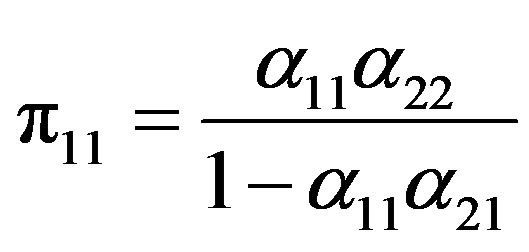 (6)
(6)
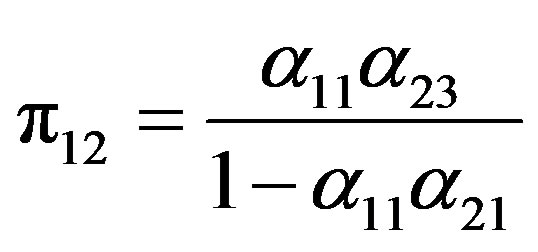 (7)
(7)
 (8)
(8)
 (9)
(9)
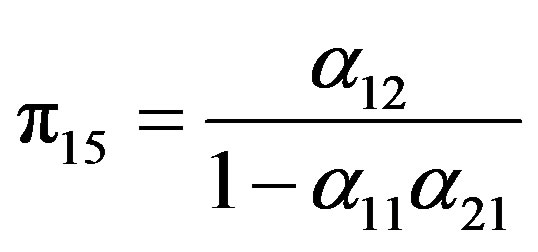 (10)
(10)
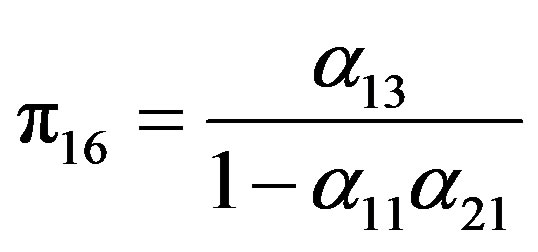 (11)
(11)
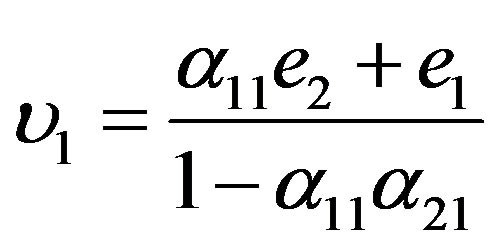 (12)
(12)
 (13)
(13)
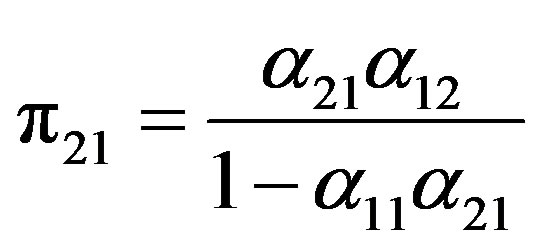 (14)
(14)
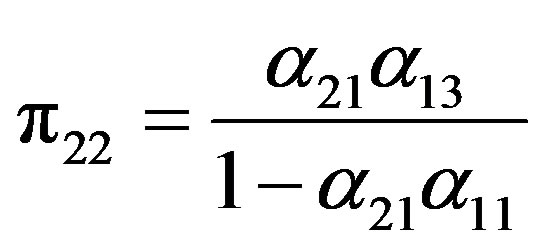 (15)
(15)
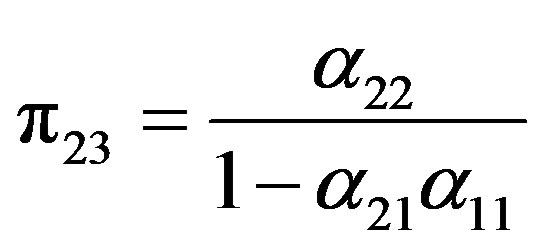 (16)
(16)
Table 2. Identification tsst of condition order.
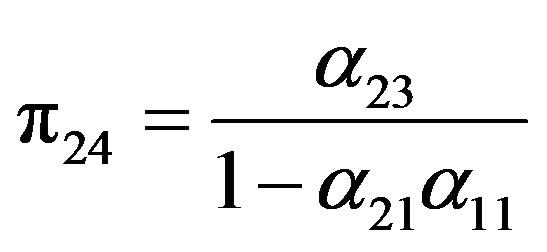 (17)
(17)
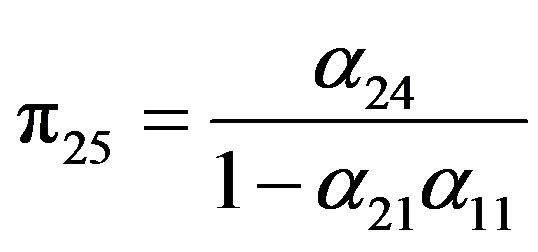 (18)
(18)
 (19)
(19)
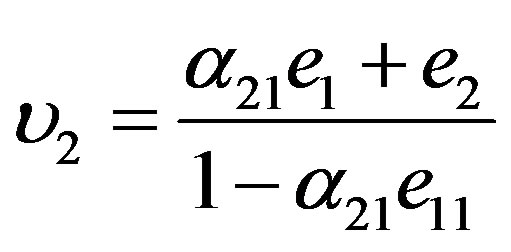 (20)
(20)
3. Finding and Analysis
3.1. Result of Estimation Equation and Test
A. Result of Estimation Equation (1)
Based on the calculation of data, the result can be seen as follows:

B. Testing Individual Regression Coefficient-Estimation Equation (1)
Based on the calculation of data, the result can be seen in Table 3.
C. Testing Overall Regression Coefficient-Estimation Equation (1)
Based on the calculation of data, the result can be seen in Table 4.
D. Result of Estimation Equation (2)
Based on the calculation of data, the result can be seen as follows:

Table 3. Testing partial significance Equation (1).
Table 4. Testing overall significance Equation (1).
E. Testing Individual Regression Coefficient-Estimation Equation (2)
Based on the calculation of data, the result can be seen in Table 5.
F. Testing Overall Regression Coefficient-Estimation Equation (2)
Based on the calculation of data, the result can be seen in Table 6.
3.2. Testing of Classic Estimation
The result of Classic Estimation that every equation in this research passes the classic estimation problem can be seen belows (Table 7).
Table 5. Testing partial significance Equation (2).
Table 6. Testing partial significance Equation (2).
Table 7. Testing classic estimation.
4. Economic Analysis
Ÿ 4.1. Economic Analysis—Equation (1)
Ÿ As it is mentioned in the theory of demand; if the price of goods increases, the demand for consumers’ goods will decrease. Based on the result of calculation, it is obtained that Variable Pr_mbl is positive but not significant to Japanese Sedan Automobile demand in Indonesia. It is caused by consumers’ expectation. The change of consumers’ expectation will cause the change of demand. For example, if a consumer thinks that the price of the car will increase in the next year, some consumers will increase their automobile demand today before the price does increase. In other word, the expectation of decreasing the price in the future will cause the consumers postpone buying their automobile demand today. Another reason is the consumers’ interest. Consumers’ choices are affected by consumers’ preferences. Preference is just consumers’ like and dislikes. Although the price of automobile increases, the consumers’ interest for that automobile will make the buy it. Besides the factors above, the other factors determine society preferences for Japanese Sedan Automobile, such as year of manufacture, taxes, equipment accessories, make (brand), motor vehicle license address, quality of components, condition of the car and the use of fuel as in addition to other factors which influence the demand
Ÿ Keynes says on his consumption theory; there is a tendency if a person’s income increases, the consumption of goods will increase. We can make an analogy that the consumption is the same as the demand (request). Based on the result of calculation, it s obtained that Variable PDB_kap has positive significance influence to Japanese Sedan Automobile in Indonesia. The result is certainly in accordance with Keynes’ theory previously proposed. This is supported by the development of the increase of income per capital every year from 1980 until 2005. Despite its growth is not too large
Ÿ The World Economic Recession is mainly caused by the low rate of PDB growth in developed countries resulted the weak demand for exported goods from Indonesia which gives further impact on deficit balance of Indonesia’s Trade Balance. The next cause is that the available Repay currency for economic development process and the availability of Dollars needed to finance or fund the imported goods becomes low. The low of imported goods and components or economy activity—especially industry—can reduce the production capacity in the country, and then it gives negative impact on economic growth. In the peak of economic crises in 1988, the economic growth rate fell dramatically negative 13.13%. The condition was worsening by the depreciation of Indonesia Repay exchange rate. Since the crises until December 2001, Repay depreciated by 48.7%, resulting in an impact in the development of the national economy both on monetary and real sectors including the automotive industry. The economic crises influenced the increase of the price of basic material of vehicle that ultimately led into the increase of automobile price. Based on the calculation, it is obtained that the Variable Du has negative significance effect on demand of Japanese Sedan Automobile in Indonesia. The result is in accordance with the theory of demand; if the price of goods increases, the demand for consumers’ goods will decrease.
Ÿ 4.2. Economic Analysis—Equation (2)
Ÿ Generally it is known that; if the demand for goods increases while the offer of goods is limited, the price of goods will increase. This condition is in accordance with the result of the research that Variable Q has positive significance influence to the price of Japanese Sedan Automobile in Indonesia.
Ÿ Although the trade gives a lot of benefit, many countries restrict the free flow of trade by imposing tariffs, quotas and other barriers. According to Krugman and Maurice [6] tariff is a form of the old trade policies, and the rate is type of taxes imposed on imported goods and it is the most common trade policies enacted by the countries in the world. Lindert [7] states that the most classic of trade barriers is the tariff of imported goods. Generally, tariff can be a burden for the whole society because this practice reduces the availability of goods and increases the price. Based on the calculation, it is obtained that Variable D1 is positive but not significant to the price of Japanese Sedan Automobile in Indonesia. The condition is in accounts with the theory previously proposed. The higher the tariff is, the more the less of good consumption will be. It causes fewer consumers in goods consumption. While the result of calculation of Variable D2 and D3 shows negative significance to the price of Japanese Sedan Automobile in Indonesia. It is contradictory with the theory previously proposed. This condition is caused by economic crises which increases the price of fuel because the government reduces the fuel subsidy. The price of fuel creates domino effect for the society; one of them is the price of Japanese Sedan Automobile significantly increases. In other word, although the tariff decreased, but the increase of fuel price causes the price of automobile increased.
Ÿ The increase of goods influenced the price of basic materials of Japanese Sedan Automobile, economic crises increased the price of fuel due to government fuel subsidy reduction. The removal of fuel subsidy reduced the National Budget, using energy efficiently, eliminating fuel smuggling and it is also expected by energy price and electricity which will gradually be pushed to the efficient economic value and is ready to compete in the global market. Moreover, the purpose of the increase of fuel price is that domestic fuel price gets closer to the fuel-price market. The benefits of removal the fuel subsidy is to divert the development fund allocated for the needy sectors, rationalize of fuel price, reduce the smuggling, reduce mixing and diversify as well as energy conservation. However, the increase of fuel price creates domino effect as well for the society. One of them is the increase of Japanese Sedan Automobile price significantly. This is contradictory to the result of calculations that Variable Pr_BBM has a negative significance influence on the price of Japanese Sedan Automobile in Indonesia.
5. Conclusions and Suggestion
5.1. Conclusions
Having investigated the result of this research about the tariff and demand for Japanese Sedan Automobile. In line with this, the suggestions are as follows:
Ÿ The development of tariff on Japanese Sedan Automobile in Indonesia has decreased; it is in accordance with the signing of World Trade Organisation (WTO) agreement; the tariff reduction had a positive influence from 1980 to 1994, and from 1995 to 1997 and 1998 to 2005, it had a negative influence on Japanese Sedan Automobile demand.
Ÿ Economic crises created the increase of fuel price which had negative significant influence to Japanese Sedan Automobile demand.
Ÿ PDB per capital is positive significance to Japanese Sedan Automobile in Indonesia.
Ÿ The correlation between the prices of automobile is not in accordance with the theory of demand. The price of automobile increased while the demand for Japanese Sedan Automobile increased, even though it was not significant.
5.2. Suggestion
Having investigated the result of this research about the tariff and demand for Japanese Sedan Automobile. In line with this, the suggestions are as follows:
Ÿ The government, especially the tariff team in Department of Finance, imposes the 0% (zero percent) tariff policies for Japanese Sedan Automobile for it will increase consumers’ demand for prosperous life in the society.
Ÿ The government is expected to impose the same taxes on motors without a difference in every area or district. It will cause consumers’ accumulation in that area which imposes low taxation and influences the lack of PAD.
Ÿ The government should publish such data over the Internet for easy access by public and create the efficiency unless the automobile selling price in the market taxed by Revenue (Service Tax) in different regional autonomy reasons.
References
- McEachern, W.A. (2000) Microeconomics. Southwestern College Publishing, Chula Vista.
- Raillon, F. (1990) Indonesia Tahun 2000: TantanganIndustri Dan Tekhnologi. CV. H. Mas Agung, Jakarta.
- Muhammad, C.B. (1997) Membedah Akar Proteksi Di Indonesia. MajalahSWA, Jakarta.
- Arief, S. (1993) Metodelogi Penelitian Ekonomi. Penerbit Universitas Indonesia, Jakarta.
- Damodar, G.N. (2003) Basic Econometrics. McGraw-Hill Companies Inc., Singapore.
- Krugman, P.R. and Obstfeld, M. (2004) Ekonomi Internasional. PT. Indeks Kelompok Gramedia, Jakarta.
- Lindert, H.P. (2000) Ekonomi International. PT Bumi Aksara, Jakarta.


